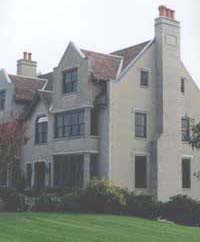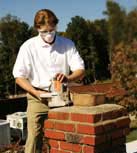 |
Q. | How many chimney pots are you supposed to put on your chimneys? | |
| A. | It is most common to put one chimney pot per flue, which can mean anywhere from one to several pots per chimney. | ||
| Q. | Do chimney pots really improve fireplace/chimney draft? | |
| A. | They can. By increasing the overall height of the chimney, and because they taper toward the top, chimney pots are often an effective way of increasing the updraft through the chimney. Many of our customers buy chimney pots for this reason. | |
| Q. | Will a chimney pot fix my smoky chimney? | |
| A. | Extending the height of an otherwise properly-designed chimney system with a chimney pot can help in an otherwise properly-designed and maintained chimney system. However, if your chimney system is not properly designed (if the flue- to-fireplace opening ratio is not correct), or it has other problems (obstructions or cracks in the flue lining, for example), nothing – including a chimney pot – will resolve the problem. In these cases, the actual system should be fixed. | |
 |
Q. | If I'm putting more than one chimney pot on a chimney, should they match? | |
| A. | Not unless you want them to! In fact, many people enjoy the creative process of mixing and matching various chimney pots. Unmatched chimney pots often add architectural interest, as shown here. Another way to achieve an interesting roofline is to match the chimney pots that sit together, but put different styles on each chimney. It’s really up to you. | ||
| Q. | Can any chimney pot go on any chimney? | |
| A. | No. Chimney pots do need to fit the flue that they're topping. When choosing a chimney pot, you first need to measure your flue(s) and your overall chimney cap width (where your chimney pot will sit). For each flue, you'll need to choose a chimney pot that is big enough (on its inside dimension) to fit outside the flue, but not so big that it goes over the edge of your chimney. | |
 |
Q. | I typically associate chimney pots with Tudors or other "British" style houses. Are there other styles of architecture that lend themselves to chimney pots? | |
| A. | We agree that no self-respecting Tudor is really complete without a chimney pot! But chimney pots have a long history in America, too, and are equally at home on many other house styles, including farmhouses, Colonials, row houses, and Victorians. And that's not all. Because chimney pots are available in hundreds of different colors and styles they have also become a hot commodity for custom and modern homes of all shapes and sizes.
The bottom line is this: chimney pots offer an interesting way to add to the character and appearance of your home. With our huge selection of new and antique chimney pots from around the world, you are certain to find just the right chimney pot for your house or building. |
||
| Q. | Where do chimney pots come from? | |
| A. | Lots of people think of chimney pots as being British - and many are. But the truth is that chimney pots have a longwonderful history in the United States, Australia, India and other countries as well. If you'd like to learn more about thehistory of chimney pots, go to: World and American History of Chimney Pots | |
 |
Q. | Are chimney pots difficult to install? Will I need to hire someone specialized to put one on my chimney? | |
| A. | Chimney pots are not difficult to install, and we provide step-by-step instructions right here on our website: Installation Tips. Of course, you may wish to hire a professional if you are uncomfortable working on your roof or with mortar. | ||
 |
Q. | It looks like the tops of chimney pots are open. Won't animals or leaves get in? | |
| A. | While it's a brave animal that dares to climb down a flue, it occasionally does happen. And yes, sometimes leaves, acorns, or other materials can get in, too. For this reason, some people opt to attach a piece of wire mesh to the top of their chimney pot. This is easily accomplished using silicone caulk, and you won't see it once your chimney pot is installed on the chimney. Here's a tip: The job will be easier, quicker, and safer if you attach the mesh to the chimney pot before you bring it up to the roof. For more on this, see our Installation Tips. | ||
| Q. | What about sparks - do I need to worry about them getting out? | |
| A. | Many people attach a piece of wire mesh to the top of their chimney pot. If the mesh is small enough (less than ½"), it may also qualify as a spark arrestor. For instructions on how to do this, see Installation Tips. Of course, national fire safety codes are occasionally updated, and local codes vary from state to state and town to town. To be sure you're meeting the latest requirements for a spark arrestor, it's always a good idea to check current building codes. | |
 |
Q. | I want my chimney pot to last forever. What do I have to do to care for it? | |
| A. | Actually, chimney pots require very little care and they rarely break while attached to the chimney. But about every 10 years (or better yet, whenever you have your chimney swept), you should inspect the mortar that holds your chimney pot onto the chimney. If it looks cracked or worn, you may need to patch it or reseat the chimney pot. | ||
 |
Q. | I live in a particularly windy area. Are there certain chimney pots more suited to windy conditions? | |
| A. | Yes. There are a number of chimney pots that may help if wind down the chimney is a problem. Some of these include the Bradford Windguard, the Halifax Hooded Three Bowl, the Leeds Scullery Hooded, the Queensland Hood, the Leeds H Pot, the Bradford Windguard, and the Short Knight. To look at these and other chimney pots, visit our Online Catalog | ||
| Q. | Can the shape and height of the chimney pot make a difference in its function? | |
| A. | Shape and height play important roles in both the function and the appearance of chimney pots. Although most people today buy chimney pots for purely aesthetic reasons, they can also serve as an effective way of improving the updraft through a chimney flue.
Because chimney pots increase the overall height of the chimney, and because they taper (get narrower) as they go up, they channel air up and out of the chimney at a faster pace. This "pulls" the air up from the fireplace or woodstove (increasing draft) and lessens the likelihood that cold air will come down the flue (downdraft). |
|
| Q. | How do I pick a chimney pot that suits the style of my home or building? | |
| A. | Shape, height, size, and color all play a role in the visual partnership between chimney pots and buildings they adorn. For example, many people feel that large, angular chimney pots can impart a sense of strength to a building's facade. Small, rounded chimney pots are often chosen to communicate coziness and warmth. Some customers choose antique chimney pots as a way to create a particular period style during the construction of a new, period-style home. Others want to restore the original style of an older home. But in the end, it really comes down to your own personal preference. Some things to think about:
|
|
| Q. | How tall should your chimney pots be? | |
| A. | The height of the chimney pot can be very important. Remember, once you install your chimney pot, it will be viewed from ground level. With that in mind, ask yourself the following questions:
|
|
||||||||||||||||||||||